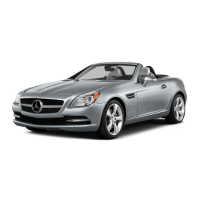X
Keep the brake pedal depressed until the
emergency braking situation is over.
ABS prevents the wheels from locking.
The brakes function as usual again if:
R
you release the brake pedal
R
there is no longer any danger of a collision
R
no obstacle is detected in front of your vehicle
Adaptive Brake Assist is then deactivated.
Up to the maximum vehicle speed, adaptive
Brake Assist can react to moving obstacles that
have already been recognized as such at least
once over the period of observation. Adaptive
Brake Assist does not react to stationary obsta-
cles.
In particular, the detection of obstacles can be
impaired if:
R
dirt on the sensors or anything else covering
the sensors
R
snow or heavy rain
R
interference from other radar sources
R
there are strong radar reflections, for exam-
ple in parking garages
R
a narrow vehicle traveling in front, e.g. a
motorbike
R
a vehicle traveling in front on a different line
If adaptive Brake Assist is not available due to a
malfunction in the radar sensor system, the full
brake boosting effect with the help of BAS
remains available.
Following damage to the front end of the vehicle,
have the configuration and operation of the
radar sensor checked at a qualified specialist
workshop. This also applies to collisions at slow
speeds where there is no visible damage to the
front of the vehicle.
Lane Tracking package
Blind Spot Assist
General notes
Blind Spot Assist uses a radar sensor system to
monitor the areas on both sides of your vehicle.
It supports you from speeds of approximately
20 mph (30 km/h). A warning display in the
exterior mirrors draws your attention to vehicles
detected in the monitored area. If you then
switch on the corresponding turn signal to
change lane, you will also receive an optical and
audible collision warning. For this purpose, Blind
Spot Assist uses sensors in the rear bumper and
behind the protective strips of the B-pillars.
Important safety notes
G
WARNING
Blind Spot Assist does not react to:
R
vehicles overtaken too closely on the side,
placing them in the blind spot area
R
vehicles which approach with a large speed
differential and overtake your vehicle
As a result, Blind Spot Assist may not give
warnings in such situations. There is a risk of
an accident.
Always observe the traffic conditions care-
fully, and maintain a safe lateral distance.
Blind Spot Assist is only an aid. It may fail to
detect some vehicles and is no substitute for
attentive driving.
i
USA only:
This device has been approved by the FCC as
a "Vehicular Radar System". The radar sensor
is intended for use in an automotive radar
system only. Removal, tampering, or altering
of the device will void any warranties, and is
not permitted by the FCC. Do not tamper with,
alter, or use in any non-approved way.
Any unauthorized modification to this device
could void the user’s authority to operate the
equipment.
Monitoring range of the sensors
In particular, the detection of obstacles can be
impaired in the case of:
R
dirt on the sensors or anything else covering
the sensors
R
poor visibility, e.g. due to fog, heavy rain or
snow
R
narrow and short vehicles, e.g. motorcycles
or bicycles
R
very wide lanes
R
narrow lanes
R
vehicles not driving in the middle of their lane
R
barriers or other road boundaries
Vehicles in the monitoring range are then not
indicated.
144
Driving systems
Driving and parking

